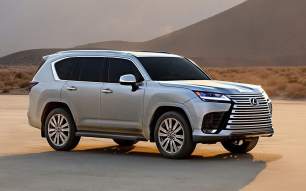This Lexus feels tighter and better controlled than previous iterations on sealed surfaces, but it’s still a big rig so it’s no surprise when body roll continually creeps in, with this hefty SUV revealing wallowing tendencies even at optimal ride height.
The suspension set-up – adjustable dampers, double wishbones at the front, a four-linkage rigid axle at the rear, stabiliser bars front and rear – irons out any major issues, but, even with consistent support from the adaptive variable suspension, it’s not perfect.
Steering is light and precise and adds to this posh 2690kg beast’s overall feeling of low-key composure.
This is a very nice cabin in which to spend time as NVH (noise, vibration and harshness) levels are kept to a minimum.
As mentioned earlier, the drive modes include normal, eco, sport and each adjusts throttle response, engine outputs, and gearshifts to suit the driver and the driving conditions.
Now for a few on-road niggles…
The brake pedals feel too spongy in their action – from stomp to stop – but the ventilated disc brakes front and rear do manage to wrench the Lexus to a controlled halt when needed.
The V6 and auto work well together, and though that transmission remains a smooth shifter, 10 gear ratios still seem like too many to me but, alas, that’s the way of the world.
To the off-road portion of this test…
The LX500d is a great open-road tourer but it does reveal some flaws when it comes to 4WDing – but more about those later.
As well as its robust mechanicals, the Lexus has off-road-capable Cruiser underpinnings with dirt-biased tech thrown into the mix as well.
There’s plenty of glass around so driver-to-track visibility is fine, steering feels light but takes on a clinical precision during low-speed, low-range 4WDing.
And ‘clinical’ is exactly how the Lexus continues to feel off-road – with multi-terrain select driving modes offering auto, dirt, sand, mud, deep snow, and rock options; with a multi-terrain monitor and panoramic view helping you ‘see’ everywhere on the track; with active height control helping you to lift the vehicle’s body in order to improve off-road angles at the push of a button; and don’t forget about downhill assist control, hill-start assist, crawl control, and off-road traction control.
The danger is that – with so much tech working away at making everything so easy and safe – the driver feels completely removed from the off-road experience. The LX500d isn’t the only culprit, not by a long shot; most of the current crop of off-road vehicles are increasingly offering a sanitised, hyper-controlled version of 4WDing rather than the visceral experience many of us know and love. I’m old and grumpy, sue me.
Our test vehicle has all-season Dunlop Grandtrek 265/50R22 112V tyres, which are fine for sealed surfaces, but they’re not at all suited to the demands of low-range 4WDing in tough conditions, even more so on these 22-inch rims.
Unbraked towing capacity is 750kg, braked towing capacity is 3500kg. The LX500d has a gross vehicle mass (GVM) of 3280kg and a gross combination mass (GCM) of 6780kg.
It has a full-size spare tyre and that’s mounted under the rear cargo area.

